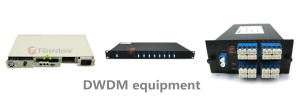5:16 AM What Is DWDM? | |
In 1980s, the first generation called wideband WDM (wavelength division multiplexing) using two widely spaced wavelengths in the 1310nm and 1550nm appeared. In early 1990s, the second generation narrowband WDM with two to eight channels was used. But people would never be satisfied with network transmission rate. They want to see videos or watch movies which require a large amount of bandwidth capacity. Because of these consumers’ demands for bandwidth, by the mid-1990s, DWDM (dense wavelength division multiplexing), the new generation of optical fiber communication technology emerged. DWDM is a technology that puts data from different sources together on a single optical fiber, with each signal carried simultaneously on its own separate light wavelength. Advantages After DWDM came into the world, it lays the foundation for the traditional electronic networking developing into optical networking. It makes optical fiber fully applied and brings many advantages to human beings.
Applications Since DWDM has so many advantages, DWDM were widely applied in transport networks and analog video transport networks (such as hybrid fiber/coax CATV/data networks). It’s also used in various specific networks, for example, sensor networks, remote radar networks, and telespectroscopic process control networks. And DWDM is still popular in photonic technologies because it supports more bandwidth at low cost and it can protect and reconfigure the large networks well. DWDM Equipment At present there are some related DWDM equipment and they are optical amplifier, optical add-drop multiplexer (OADM), optical cross connect (OXC), multiplexer/demultiplexer (MUX/DEMUX) modules, DWDM Transceivers, etc.
An optical amplifier is a device that amplifies an optical signal directly, without the need to first convert it to an electrical signal. An optical amplifier may be thought of as a laser without an optical cavity, or one in which feedback from the cavity is suppressed. Optical amplifiers are important in optical communication and laser physics. Now Erbium Doped Fiber Amplifier (EDFA) is the most common type and used as a building block in DWDM system. It can efficiently amplify light in the 1.5μm wavelength region where telecom fibers can’t reach. It could provide about 40-50nm of bandwidth and gain spectrum.
Optical add-drop multiplexers are used to add and drop wavelength channels from a DWDM multi-channel stream. In other words, they are designed for wavelength division in DWDM system. The main function is to couple two or more wavelengths into a fiber.
An optical cross-connect (OXC) is a device to switch high-speed optical signals in a fiber optic network, such as an optical mesh network. By connecting it with DWDM, wavelength switching and wavelength conversion happen. It meets the requirement that the wavelength routing can be reconfigured but still maintains its transparent nature in DWDM networks. | |
|
| |
| Total comments: 0 | |

